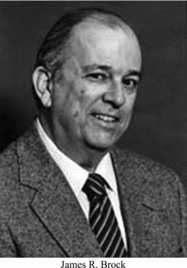Abstract
Copyright 2012 American Association for Aerosol Research

James R. Brock passed away December 12, 2011. He was professor emeritus (Kenneth A. Kobe Professor) in chemical engineering at the University of Texas, and active throughout his career as an internationally known aerosol scientist. He was a distinguished member of the American Association for Aerosol Research, including the recipient of the Sinclair Award in 1992. Throughout his faculty appointment at the University of Texas beginning in 1960, his research was heavily focused on the theory of aerosol dynamics as embodied in environmental science, rarified gas dynamics, statistical mechanics, thermodynamics and reaction kinetics.
After completing undergraduate studies at Rice University, Dr. Brock's career was stimulated beginning with his graduate work (1954–1960) at the University of Wisconsin's “chemical engineering school of transport phenomena” which led the profession into the formalism of modern fluid dynamics.
His research interests were stimulated during his (1962–1963) postdoctoral appointment with the “irreversible theromodynamicist,” Dr. Illya Prigogine at the University of Libre de Belgique. Dr. Brock's early research applying principles of rarified gas dynamics to early research on nanoparticles. This work culminated in the 1970 book, The Dynamics of Aerocolloidal Systems coauthored with G. M. Hidy. In their youthful efforts, they hoped that this book would be a multiphase equivalent of Chapman and Cowling's classical treatise, “Kinetic Theory of Gases.” Their monograph produced a “rigorous” framework for international aerosol science from the 19th century forward to the 1960s, captured by N. A. Fuchs in his famous book, Mechanics of Aerosols.
Dr. Brock continued his theoretical and experimental studies through the 1990s, which resulted in more than 150 journal papers, ten book chapters, 20 patents and numerous unpublished reports. His late work with students followed his long-term interest in the Knudsen range of ≤5 nm diameter nanoparticles, their phase change and their chemistry as an outgrowth of rarified gas dynamics. Among his more celebrated studies are those on diffusiophoresis and thermophoresis in the Knudsen transition regime. This work was regarded by Fuchs as the definitive work in this area. His research investigated the production of nanoparticles and practical applications for etching semiconductor devices by aerosol jets and surface cleaning of semiconductor devices. A strength of his work was his application of mathematical techniques unknown to aerosol scientists to obtain solutions to otherwise intractable problems. His recent theoretical research included finite element techniques for solving Maxwell's equations for scattering and absorption of light by nanoparticles for systems that are analytically intractable. This work resulted in obtaining a description for morphology-dependent resonances in spherical particles.
Dr. Brock was visiting professor at the University of Paris in 1973 and at the Tokyo Institute of Technology in 1988. In 1997 he lectured on nanoparticle synthesis at the NATO Advanced Study Institute in St. Petersburg, Russia. He served on committees for air pollution research with the Environmental Protection Agency and the Technical Advisory Committee for the Texas Air Control Board. He was a consultant to the US Army and Air Force as well as companies in the private sector and served on the editorial boards of several publications, including the Journal of Colloid Science and Aerosol Science and Technology.
In recognition of his research contributions he was the recipient of the Distinguished Service Award in 1987 from the U.S. Army Research and Development Center at Aberdeen Proving Ground. He also was awarded the University of Texas’ Hocutt Distinguished Centennial Engineering Research Award in 1999.
Although Brock attended relatively few domestic meetings, an exception was the annual aerosol meeting at Aberdeen. He did enjoy foreign travel and was probably better known for his presentations in Europe than those in the states. Typical of those were his discussions with C. N. Davies in Vienna on the Fuchs correction for dynamics in the free molecule regime.
Dr. Brock's long term interest in environmental protection was fostered by his work in air quality research. He once noted prophetically that if one wanted to prevent air pollution, research should concentrate on a pollenless tree. Perhaps the comment foresaw the finding that natural hydrocarbon emissions from vegetation are a potentially important contributor to ozone and organic aerosol production.
Dr. Brock's colleagues knew him for his quiet demeanor, but ability to resolve technical disputes among students and researchers. One example was a divisive argument between C. N. Davies and B. V. Derjaguin over one of the latter's revised papers in which Davies refused to publish in the Journal of Aerosol Science. Brock worked with Milton Kerker to have Derjaguin's response published in the Journal of Colloid and Interface Science, thus closing the issue.
Dr. Brock devoted his time and energy to his family at high priority. He is survived by his wife, Mary Lou and his two daughters. He was an active church member, and a lover of classical music and world history; his service to his profession, his university, his country and the State of Texas though perhaps hidden was nevertheless significant in wisdom and counsel.
Dr. Brock guided and educated a number of students and post-doctoral fellows at the University of Texas, and on his visits to a number of other institutions. His interactions with colleagues provided an important late 20th century intellectual framework for merging experimental science of aerosols with contemporary dynamical theory. He will be sorely missed not only by his family, but also by his colleagues in aerosol science and engineering.
Acknowledgments
Photo courtesy of the Department of Chemical Engineering, University of Texas